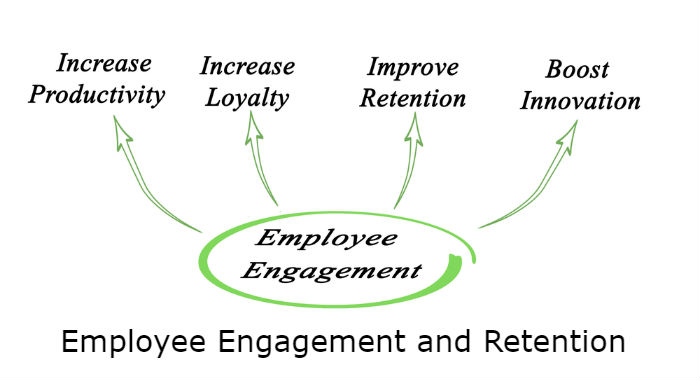Employee engagement is a critical element for the success of any organization. It refers to the emotional commitment and involvement an employee has towards their company and its goals. Engaged employees are more productive, satisfied, and likely to remain with the organization, positively influencing overall business performance. This article explores the significance of employee engagement, effective strategies for enhancing it, creating a positive work environment, retention techniques to keep top talent, and methods for measuring and improving engagement and retention.
1. The Importance of Employee Engagement

Employee engagement is a critical factor in the success of any organization. It refers to the emotional commitment and involvement an employee has towards their organization and its goals. Engaged employees are passionate about their work, take pride in their contributions, and are motivated to achieve their best. The significance of employee engagement extends beyond individual performance, impacting overall business outcomes and creating a positive workplace culture.
Benefits of Employee Engagement
The benefits of employee engagement are manifold and have a direct influence on the productivity and success of a business. Engaged employees exhibit higher levels of job satisfaction, which translates to increased productivity. When employees are engaged, they are more likely to go above and beyond their basic job requirements, often referred to as discretionary effort. This additional effort can lead to higher levels of innovation, efficiency, and quality in the work produced.
Moreover, engaged employees tend to have better relationships with their colleagues and superiors, fostering a collaborative and supportive work environment. This improved teamwork can result in more effective problem-solving and decision-making processes, as employees feel more comfortable sharing ideas and feedback. A strong sense of belonging and connection to the company can also lead to lower turnover rates, as engaged employees are less likely to seek opportunities elsewhere.
Statistics and Research
Numerous studies and surveys have highlighted the positive correlation between employee engagement and organizational performance. For instance, a Gallup poll found that companies with high employee engagement scores experience 21% higher profitability and 17% higher productivity compared to those with low engagement levels. Additionally, these companies see a 41% reduction in absenteeism and a 40% decrease in turnover rates.
Research by the Harvard Business Review reveals that engaged employees are 87% less likely to leave their organizations, underscoring the role of engagement in employee retention. Furthermore, organizations with a high level of employee engagement benefit from a 10% increase in customer ratings, indicating that engaged employees are more likely to deliver exceptional customer service.
Impact on Company Culture
Employee engagement plays a pivotal role in shaping and maintaining a positive company culture. A culture that prioritizes engagement fosters a sense of community and shared purpose among employees. When employees feel valued and recognized for their contributions, they are more likely to be loyal and committed to the organization. This sense of loyalty can lead to a stronger alignment between individual and organizational goals, creating a cohesive and driven workforce.
In addition, an engaged workforce can serve as a powerful tool for attracting top talent. Potential candidates are more likely to be drawn to companies with a reputation for high employee engagement, as it signals a positive and supportive work environment. This can give organizations a competitive edge in the job market, enabling them to attract and retain the best talent.
Challenges of Employee Engagement
Despite its importance, achieving high levels of employee engagement can be challenging. Factors such as poor management, lack of career development opportunities, and insufficient recognition can contribute to disengagement. Additionally, external factors like economic downturns or industry changes can impact employee morale and engagement levels.
Organizations must be proactive in addressing these challenges by implementing strategies that promote engagement. This includes providing regular feedback, offering opportunities for professional growth, and recognizing and rewarding employee achievements. Leadership plays a crucial role in setting the tone for engagement, and managers must be trained to effectively communicate and connect with their teams.
2. Strategies for Enhancing Employee Engagement

Employee engagement is pivotal for organizational success, as engaged employees are more productive, motivated, and likely to stay with the company long-term. Here are some effective strategies to enhance employee engagement:
Communication
Open and transparent communication is the cornerstone of employee engagement. Employees need to feel informed about company goals, changes, and their role in the organization’s success. Regular updates, whether through newsletters, meetings, or internal social platforms, keep employees in the loop and foster a sense of inclusion.
Two-way communication is equally important. Employees should have the opportunity to voice their opinions, provide feedback, and contribute ideas. Encouraging this dialogue shows that the organization values their input and is willing to listen. This can be facilitated through regular town hall meetings, suggestion boxes, and anonymous surveys.
Moreover, effective communication from leadership is crucial. Leaders should be approachable and convey messages with clarity and sincerity. This builds trust and ensures that employees feel secure and understood within the organization.
Recognition and Rewards
Recognition and rewards are powerful motivators for employee engagement. Acknowledging employees for their hard work and achievements fosters a positive work environment and encourages them to maintain high performance levels.
Recognition programs can be formal or informal. Formal programs might include employee of the month awards, bonuses, or public acknowledgments during meetings. Informal recognition can be as simple as a thank-you note, a shout-out in a team meeting, or a small token of appreciation.
Rewards systems should be fair and transparent, ensuring that all employees have the opportunity to be recognized. It’s essential to align rewards with the company’s values and goals, promoting behaviors and achievements that contribute to the organization’s success.
Professional Development
Offering opportunities for professional development is a significant factor in employee engagement. When employees feel that the organization is invested in their growth and career advancement, they are more likely to be committed and motivated.
Training and development programs should be tailored to meet the needs of the employees and the organization. This can include workshops, online courses, mentoring, and opportunities for cross-functional projects. Encouraging employees to set personal development goals and providing the resources to achieve them demonstrates the organization’s commitment to their professional growth.
Career pathing is another essential aspect. Providing clear and achievable career progression paths helps employees visualize their future within the company. Regular career development discussions and succession planning can also help identify and nurture future leaders.
Creating a Positive Work Environment
A positive work environment is fundamental to employee engagement. This includes both the physical workspace and the organizational culture.
Work-life balance is a critical component. Organizations should promote policies that support employees’ ability to balance their personal and professional lives, such as flexible working hours, remote work options, and generous leave policies.
Company culture should be inclusive, supportive, and aligned with the values of the employees. Encouraging teamwork, celebrating diversity, and fostering a sense of community can contribute to a positive work environment. Leadership should model these values and behaviors, as their actions significantly influence the overall culture.
Leadership and Management
Effective leadership is crucial in driving employee engagement. Leaders and managers play a pivotal role in shaping the work environment and influencing employees’ attitudes and behaviors.
Leadership training should focus on developing skills such as empathy, active listening, and conflict resolution. Leaders who are approachable, supportive, and empathetic are more likely to foster engaged teams. They should also be transparent in their decision-making and communicate the company’s vision and goals clearly.
Empowering managers to take ownership of engagement initiatives can have a significant impact. Managers should regularly check in with their team members, provide constructive feedback, and recognize their achievements. Building strong, trust-based relationships between managers and employees is essential for engagement.
3. Creating a Positive Work Environment

A positive work environment is essential for fostering employee engagement and retention. It is a multifaceted concept that encompasses both the physical workspace and the organizational culture. A supportive, inclusive, and engaging work environment can significantly impact employees’ well-being, productivity, and loyalty to the organization. Here are some key elements to consider when creating a positive work environment.
Work-Life Balance
Work-life balance is a critical component of a positive work environment. Employees need to feel that they can balance their professional responsibilities with their personal lives without excessive stress or burnout. Organizations can support work-life balance through flexible working hours, remote work options, and generous leave policies. Flexible working hours allow employees to manage their time effectively, accommodating personal commitments and reducing stress. Remote work options, particularly in the post-pandemic era, have become increasingly important, offering employees the flexibility to work from home or other locations. Generous leave policies, including vacation, sick leave, and parental leave, ensure that employees can take the time they need for rest, recovery, and personal matters without feeling pressured to return to work prematurely.
Physical Workspace
The physical workspace plays a crucial role in creating a positive work environment. A well-designed office can enhance productivity, creativity, and overall job satisfaction. Key elements of a conducive physical workspace include:
- Ergonomic Furniture: Providing comfortable and ergonomic furniture helps prevent physical strain and promotes well-being.
- Natural Light: Ample natural light can improve mood, energy levels, and overall health.
- Cleanliness and Organization: A clean and organized workspace reduces stress and creates a more pleasant environment.
- Collaborative Spaces: Areas designed for collaboration encourage teamwork and innovation.
Investing in the physical workspace demonstrates that the organization values its employees’ comfort and well-being, which can boost morale and engagement.
Company Culture
Company culture is the foundation of a positive work environment. A supportive and inclusive culture fosters a sense of belonging and motivates employees to contribute to the organization’s success. Key aspects of a positive company culture include:
- Inclusivity: Embracing diversity and promoting inclusivity ensures that all employees feel valued and respected. This can be achieved through diversity training, inclusive policies, and a zero-tolerance approach to discrimination.
- Teamwork and Collaboration: Encouraging teamwork and collaboration helps build strong relationships among employees and promotes a sense of community. Team-building activities, collaborative projects, and open communication channels can enhance teamwork.
- Recognition and Appreciation: Regularly recognizing and appreciating employees’ efforts and achievements fosters a positive and motivating environment. This can be done through formal recognition programs, informal acknowledgments, and celebrations of milestones and successes.
Leadership and Management
Effective leadership and management are crucial in creating and maintaining a positive work environment. Leaders and managers set the tone for the organizational culture and influence employees’ attitudes and behaviors. Key leadership practices that contribute to a positive work environment include:
- Approachability: Leaders who are approachable and open to feedback create a supportive environment where employees feel comfortable voicing their concerns and ideas.
- Empathy: Demonstrating empathy and understanding towards employees’ personal and professional challenges fosters trust and loyalty.
- Transparency: Transparent communication about company goals, changes, and decisions builds trust and ensures that employees feel informed and included.
Professional Development
Providing opportunities for professional development is another essential aspect of a positive work environment. When employees feel that their growth and career advancement are supported, they are more likely to be engaged and committed to the organization. Professional development initiatives can include:
- Training Programs: Offering regular training sessions to enhance skills and knowledge.
- Mentorship: Implementing mentorship programs to guide and support employees in their career development.
- Career Pathing: Providing clear career progression paths and opportunities for advancement within the organization.
4. Retention Techniques to Keep Top Talent

Retaining top talent is essential for maintaining a competitive edge and ensuring long-term success. High turnover rates can be costly and disruptive, making it crucial for organizations to implement effective retention strategies. Here are some key techniques to keep top talent engaged and committed to your company.
Competitive Compensation
Offering competitive compensation is one of the most fundamental retention techniques. Top talent expects to be fairly compensated for their skills, experience, and contributions. This includes not only a competitive base salary but also bonuses, stock options, and other financial incentives.
Regular Salary Reviews: Conduct regular market salary reviews to ensure that your compensation packages are in line with industry standards. This helps in retaining employees who might otherwise be tempted by higher offers from competitors.
Performance-Based Rewards: Implement performance-based bonuses and incentives to reward employees for their hard work and achievements. This not only motivates employees to perform at their best but also fosters a culture of meritocracy.
Comprehensive Benefits Package
A comprehensive benefits package is another critical element in retaining top talent. Employees value benefits that support their health, well-being, and work-life balance.
Health and Wellness Programs: Offer robust health insurance plans, including medical, dental, and vision coverage. Additionally, consider providing wellness programs such as gym memberships, mental health support, and wellness workshops.
Retirement Plans: Provide attractive retirement plans, such as 401(k) matching, to help employees secure their financial future. This demonstrates a long-term commitment to their well-being.
Work-Life Balance: Implement policies that promote a healthy work-life balance, such as flexible working hours, remote work options, and generous leave policies. These benefits are highly valued by employees and can significantly impact their decision to stay with the company.
Career Pathing and Professional Development
Top talent is often ambitious and driven by career growth opportunities. Providing clear career paths and professional development programs is essential for retaining these employees.
Career Pathing: Create clear and achievable career progression paths within the organization. Regularly discuss career goals with employees and provide guidance on how they can achieve these goals within the company.
Training and Development: Offer continuous learning opportunities through training programs, workshops, and online courses. Encourage employees to acquire new skills and stay updated with industry trends. This not only enhances their capabilities but also demonstrates the organization’s investment in their professional growth.
Mentorship Programs: Implement mentorship programs that pair experienced leaders with high-potential employees. Mentors can provide guidance, support, and valuable insights, helping mentees navigate their career paths and achieve their goals.
Positive Work Environment
Creating a positive work environment is crucial for employee satisfaction and retention. A supportive and engaging workplace culture can significantly impact employees’ decision to stay with the organization.
Inclusive Culture: Foster a culture of inclusivity and diversity where all employees feel valued and respected. Implement diversity training programs and ensure that company policies promote equality and inclusiveness.
Recognition and Rewards: Regularly recognize and reward employees for their contributions and achievements. This can be done through formal recognition programs, informal acknowledgments, and celebrations of milestones and successes. Feeling appreciated and valued boosts morale and loyalty.
Employee Engagement Initiatives: Implement initiatives that promote employee engagement, such as team-building activities, social events, and employee feedback programs. Engaged employees are more likely to be committed to the organization and less likely to seek opportunities elsewhere.
Effective Leadership
Effective leadership plays a pivotal role in employee retention. Leaders and managers who are supportive, transparent, and empathetic can significantly influence employees’ decision to stay with the company.
Approachable Leadership: Ensure that leaders are approachable and open to feedback. Employees should feel comfortable discussing their concerns and ideas with their managers.
Transparent Communication: Practice transparent communication regarding company goals, changes, and decisions. Keeping employees informed and involved fosters trust and loyalty.
Supportive Management: Train managers to provide regular feedback, support employee development, and recognize their achievements. A supportive management style can enhance employee satisfaction and retention.
5. Measuring and Improving Engagement and Retention

Employee engagement and retention are critical for the sustained success of any organization. High levels of engagement often correlate with increased productivity, improved morale, and lower turnover rates. Conversely, poor engagement can lead to higher absenteeism, reduced performance, and increased costs associated with recruiting and training new employees. Here’s how organizations can measure and improve engagement and retention effectively.
Measuring Employee Engagement
Understanding current levels of employee engagement is the first step toward improvement. This can be achieved through various methods:
Surveys and Feedback
Employee Engagement Surveys: Conduct regular surveys to gauge employees’ sentiments about their work, colleagues, and the organization. These surveys should include questions about job satisfaction, alignment with company goals, and the quality of relationships with managers and peers.
Pulse Surveys: Short, frequent surveys can provide real-time insights into employee engagement levels. These are less comprehensive than annual surveys but can quickly identify emerging issues.
Exit Interviews: Collecting feedback from departing employees can provide valuable insights into why employees leave and highlight areas for improvement.
Analytics and Metrics
Key Performance Indicators (KPIs): Track metrics such as absenteeism, turnover rates, and productivity levels. High absenteeism and turnover often indicate low engagement.
Performance Data: Analyze performance reviews and productivity data to identify trends and patterns. Engaged employees typically perform better and are more productive.
Employee Net Promoter Score (eNPS): This metric measures employees’ likelihood to recommend their workplace to others. A high eNPS indicates a high level of engagement and satisfaction.
Improving Employee Engagement
Once engagement levels are measured, organizations can take targeted actions to improve them:
Communication
Transparent Communication: Ensure that communication from leadership is transparent and consistent. Regular updates about company goals, changes, and achievements help employees feel informed and involved.
Two-Way Communication: Encourage open dialogue between employees and management. Create platforms where employees can voice their opinions, concerns, and ideas without fear of retribution.
Recognition and Rewards
Recognition Programs: Implement formal recognition programs to celebrate employees’ achievements. This can include employee of the month awards, peer-to-peer recognition, and public acknowledgments during meetings.
Incentives and Rewards: Offer performance-based incentives and rewards. Tailor these rewards to individual preferences, whether monetary bonuses, additional time off, or professional development opportunities.
Professional Development
Training and Development Programs: Provide opportunities for employees to enhance their skills and advance their careers. This can include workshops, online courses, and cross-training opportunities.
Career Pathing: Develop clear career progression paths within the organization. Regularly discuss career goals with employees and provide guidance on how to achieve them.
Mentorship Programs: Pair less experienced employees with seasoned mentors who can provide guidance, support, and career advice.
Creating a Positive Work Environment
Work-Life Balance: Promote policies that support a healthy work-life balance, such as flexible working hours, remote work options, and generous leave policies.
Inclusive Culture: Foster an inclusive culture where all employees feel valued and respected. Implement diversity and inclusion training and ensure company policies promote equality.
Employee Engagement Initiatives: Organize team-building activities, social events, and wellness programs to enhance the overall work environment.
Improving Retention
Retention is closely tied to engagement. Here are additional strategies specifically aimed at improving retention:
Competitive Compensation
Regular Salary Reviews: Ensure that compensation packages are competitive and aligned with industry standards.
Performance-Based Bonuses: Offer bonuses and financial incentives based on performance to motivate and retain top talent.
Comprehensive Benefits
Health and Wellness Programs: Provide comprehensive health insurance and wellness programs to support employees’ physical and mental health.
Retirement Plans: Offer attractive retirement plans, such as 401(k) matching, to help employees secure their financial future.
Continuous Improvement
Improving engagement and retention is an ongoing process. Regularly review engagement and retention metrics, solicit feedback from employees, and adjust strategies as needed. By continuously striving to enhance the work environment and address employee needs, organizations can build a committed, motivated, and high-performing workforce.
Conclusion
In conclusion, employee engagement and retention are vital for the sustainable success of any organization. By understanding the importance of engagement, implementing effective communication, recognition, and professional development strategies, fostering a positive work environment, offering competitive compensation and benefits, and continuously measuring and improving these efforts, organizations can create a motivated, productive, and loyal workforce. Investing in employee engagement not only enhances individual performance but also drives overall organizational growth and success. Enhance your team’s success by reading “Recruiting Tips: Assessing Soft Skills” after diving into Employee Engagement and Retention.


